Determination of Strain Limits for Dimensioning Polyurethane Components
Abstract
:1. Introduction
2. Materials and Methods
2.1. Materials
2.2. Methods
2.3. Validation of the Test Method
2.4. Evaluation of the Determined Strain Limits under Simple Shear Load
3. Results and Discussion
3.1. Determination of Strain Limit
3.2. Validation of the Test Method
3.3. Evaluation of the Determined Strain Limits under Simple Shear Load
3.4. Evaluation of the Determined Strain Limits in the Context of Increasing the Lightweight Design Potential
4. Conclusions
Author Contributions
Funding
Institutional Review Board Statement
Informed Consent Statement
Data Availability Statement
Acknowledgments
Conflicts of Interest
References
- Menges, G. Erleichtertes Verständnis des Werkstoffverhaltens bei verformungsbezogener Betrachtungsweise; Fortschritts-Berichte. VDI-Z 1971, 5, 12. [Google Scholar]
- Menges, G. Das Verhalten von Kunststoffen unter Dehnung. Kunststoffe 1973, 63, 95–100. [Google Scholar]
- Kunz, J. Ein Plädoyer für die dehnungsbezogene Auslegung. Kunststoffe 2011, 4, 50–54. [Google Scholar]
- Kunz, J. Berechnung von Kunststoffkonstruktionen - Dehnungsbezogene Auslegung bei Schub und Torsion. KunststoffXtra 2016, 6, 14–17. [Google Scholar]
- Erhard, G. Designing with Plastics; Carl Hanser Verlag GmbH & Co. KG: München, Germany, 2006; ISBN 978-3-446-22590-9. [Google Scholar]
- Stommel, M.; Stojek, M.; Korte, W. FEM zur Berechnung von Kunststoff- und Elastomerbauteilen, 2., neu bearbeitete und erweiterte Auflage; Hanser: München, Germany, 2018; ISBN 9783446452831. [Google Scholar]
- Fan, J.T.; Weerheijm, J.; Sluys, L.J. High-strain-rate tensile mechanical response of a polyurethane elastomeric material. Polymer 2015, 65, 72–80. [Google Scholar] [CrossRef]
- Sarva, S.S.; Deschanel, S.; Boyce, M.C.; Chen, W. Stressestrain behavior of a polyurea and a polyurethane from low to high strain rates. Polymer 2007, 48, 2208–2213. [Google Scholar] [CrossRef]
- Tereshatov, V.V.; Senichev, V.Y. Stress–Strain Dependence of Segmented Polyurethanes and Polyurethane Ureas. J. Macromol. Sci. Part B 2015, 54, 365–380. [Google Scholar] [CrossRef]
- Johlitz, M.; Diebels, S.; Possart, W. Investigation of the thermoviscoelastic material behaviour of adhesive bonds close to the glass transition temperature. Arch. Appl. Mech. 2012, 82, 1089–1102. [Google Scholar] [CrossRef]
- Oberbach, K. Kunststoff-Kennwerte für Konstrukteure; Carl Hanser Verlag: München, Germany, 1980. [Google Scholar]
- Kunz, J. Reversibilität als Auslegungskriterium. Kunststoffe 2018, 2, 67–71. [Google Scholar]
- Palinkas, R. Materials Characterization in the Design of Castable Polyurethane Parts. Elastomer Plast. 1991, 22–33. [Google Scholar] [CrossRef]
- Lobo, H.; Hurtado, J.A. Characterization and Modeling of Non-Linear Behavior of Plastics. In Proceedings of the ABAQUS Users’ Conference; 2006. Available online: https://www.simulia.com/forms/world/pdf2006/Lobo.pdf (accessed on 10 February 2021).
- Slobodian, P.; Riha, P.; Saha, P. A highly-deformable composite composed of an entangled network of electrically-conductive carbon-nanotubes embedded in elastic polyurethane. Carbon 2012, 50, 3446–3453. [Google Scholar] [CrossRef]
- Goldschmidt, F.; Diebels, S. Modelling and numerical investigations of the mechanical behavior of polyurethane under the influence of moisture. Arch. Appl. Mech. 2015, 85, 1035–1042. [Google Scholar] [CrossRef]
- Johlitz, M.; Steeb, H.; Diebels, S.; Chatzouridou, A.; Batal, J.; Possart, W. Experimental and theoretical investigation of nonlinear viscoelastic polyurethane systems. J. Mater. Sci. 2007, 42, 9894–9904. [Google Scholar] [CrossRef]
- Yi, J.; Boyce, M.C.; Lee, G.F.; Balizer, E. Large deformation rate-dependent stress–strain behavior of polyurea and polyurethanes. Polymer 2006, 47, 319–329. [Google Scholar] [CrossRef]
- Martin, D.J.; Meijs, G.F.; Renwick, G.M.; Mccarthy, S.J.; Gunatillake, P.A. The effect of average soft segment length on morphology and properties of a series of polyurethane elastomers. I. Characteri-zation of the series. Appl. Polym. Sci. 1996, 1377–1386. [Google Scholar] [CrossRef]
- Pohl, M.; Stommel, M. Intrinsic CFRP-metal-hybrids with rubber interface for the improvement of the damping behaviour. Prod. Eng. Res. Devel. 2018, 12, 153–159. [Google Scholar] [CrossRef]
- Wang, Y.; Xue, H.; Chen, H.; Qiang, J. A dynamic visco-hyperelastic model of dielectric elastomers and their energy dissipation characteristics. Appl. Phys. A 2013, 112, 339–347. [Google Scholar] [CrossRef]
- Instron. WaveMatrix Software Manual; pp. 308–320.
- Pitarresi, G.; Patterson, E.A. A review of the general theory of thermoelastic stress analysis. J. Strain Anal. Eng. Des. 2003, 38, 405–417. [Google Scholar] [CrossRef]
- Godovsky, Y.K. Thermophysical Properties of Polymers; Springer: Berlin/Heidelberg, Germany, 1992; ISBN 9783642516726. [Google Scholar]
- Oldyrev, P.P. Determination of the fatigue life of plastics from the self-heating temperature. Polym. Mech. 1967. [Google Scholar] [CrossRef]
- Ovalle Rodas, C.; Zaïri, F.; Naït-Abdelaziz, M. A finite strain thermo-viscoelastic constitutive model to describe the self-heating in elastomeric materials during low-cycle fatigue. J. Mech. Phys. Solids 2014, 64, 396–410. [Google Scholar] [CrossRef]
- Katunin, A. Criticality of the Self-Heating Effect in Polymers and Polymer Matrix Composites during Fatigue, and Their Application in Non-Destructive Testing. Polymers 2018, 11, 19. [Google Scholar] [CrossRef] [Green Version]
- Steinberger, R.; Leitão, T.V.; Ladstätter, E.; Pinter, G.; Billinger, W.; Lang, R.W. Infrared thermographic techniques for non-destructive damage characterization of carbon fibre reinforced polymers during tensile fatigue testing. Int. J. Fatigue 2006, 28, 1340–1347. [Google Scholar] [CrossRef]
- Summa, J.; Becker, M.; Grossmann, F.; Pohl, M.; Stommel, M.; Herrmann, H.-G. Fracture analysis of a metal to CFRP hybrid with thermoplastic interlayers for interfacial stress relaxation using in situ thermography. Compos. Struct. 2018, 19–28. [Google Scholar] [CrossRef]
- Berger, D.; Zaiß, M.; Lanza, G.; Summa, J.; Schwarz, M.; Herrmann, H.-G.; Pohl, M.; Günther, F.; Stommel, M. Predictive quality control of hybrid metal-CFRP components using information fusion. Prod. Eng. Res. Devel. 2018, 12, 161–172. [Google Scholar] [CrossRef]
- Bale, J.; Valot, E.; Polit, O.; Bathias, C.; Monin, M.; Soemardi, T. Thermal phenomenon of glass fibre composite under tensile static and fatigue loading. J. Mech. Eng. Sci. 2017, 11, 2755–2769. [Google Scholar] [CrossRef]
- Mars, W.V.; Fatemi, A. Multiaxial fatigue of rubber: Part II: Experimental observations and life predictions. Fat. Frac. Eng. Mat. Struct. 2005, 28, 523–538. [Google Scholar] [CrossRef]
- Ziolkowski, A. Simple shear test in identification of constitutive behaviour of materials submitted to large deformations—Hyperelastic materials case. Eng. Trans. 2006, 54, 251–269. [Google Scholar]
- Destrade, M.; Murphy, J.G.; Saccomandi, G. Simple shear is not so simple. Int. J. Non-Linear Mech. 2012, 47, 210–214. [Google Scholar] [CrossRef]
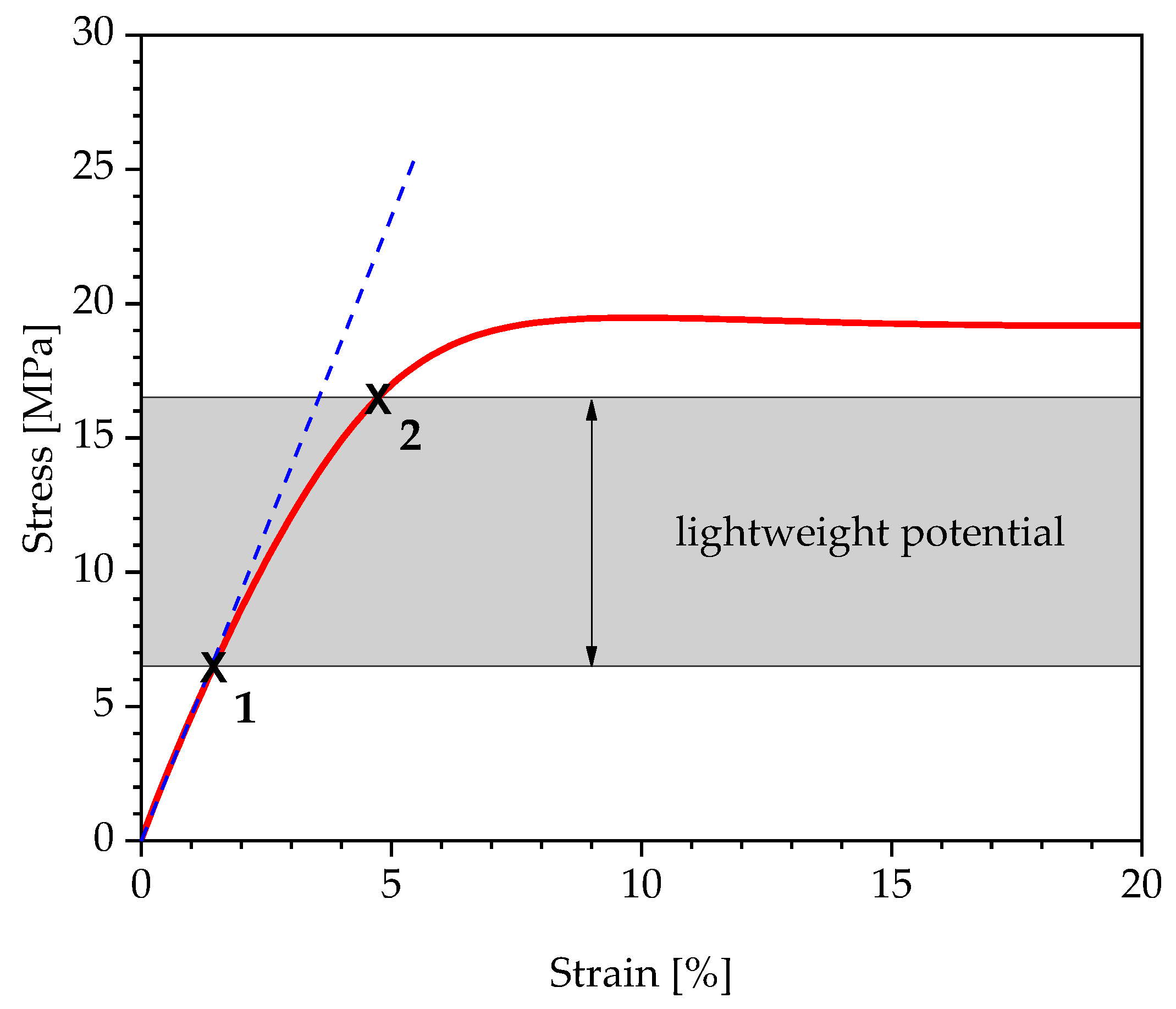

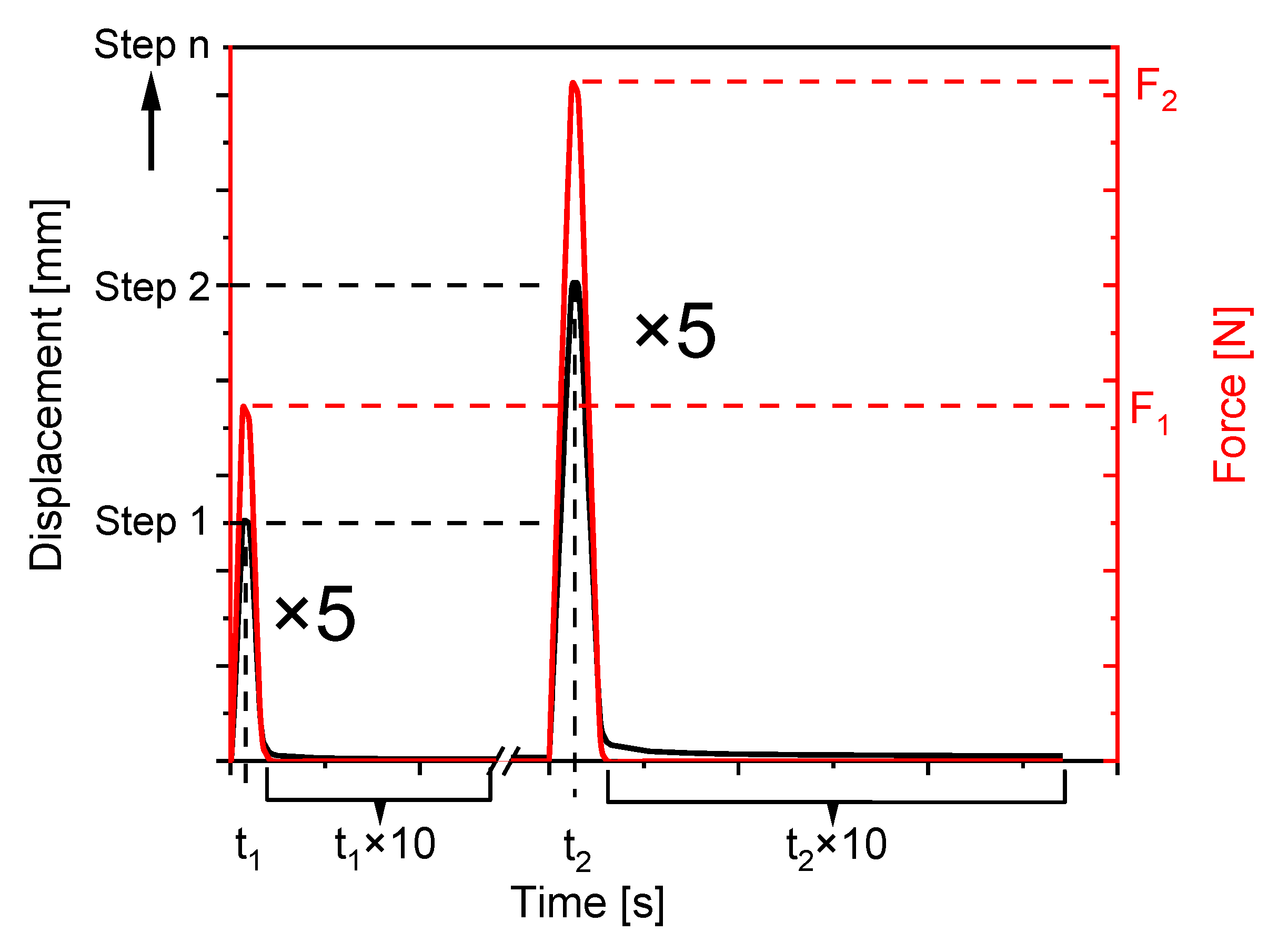
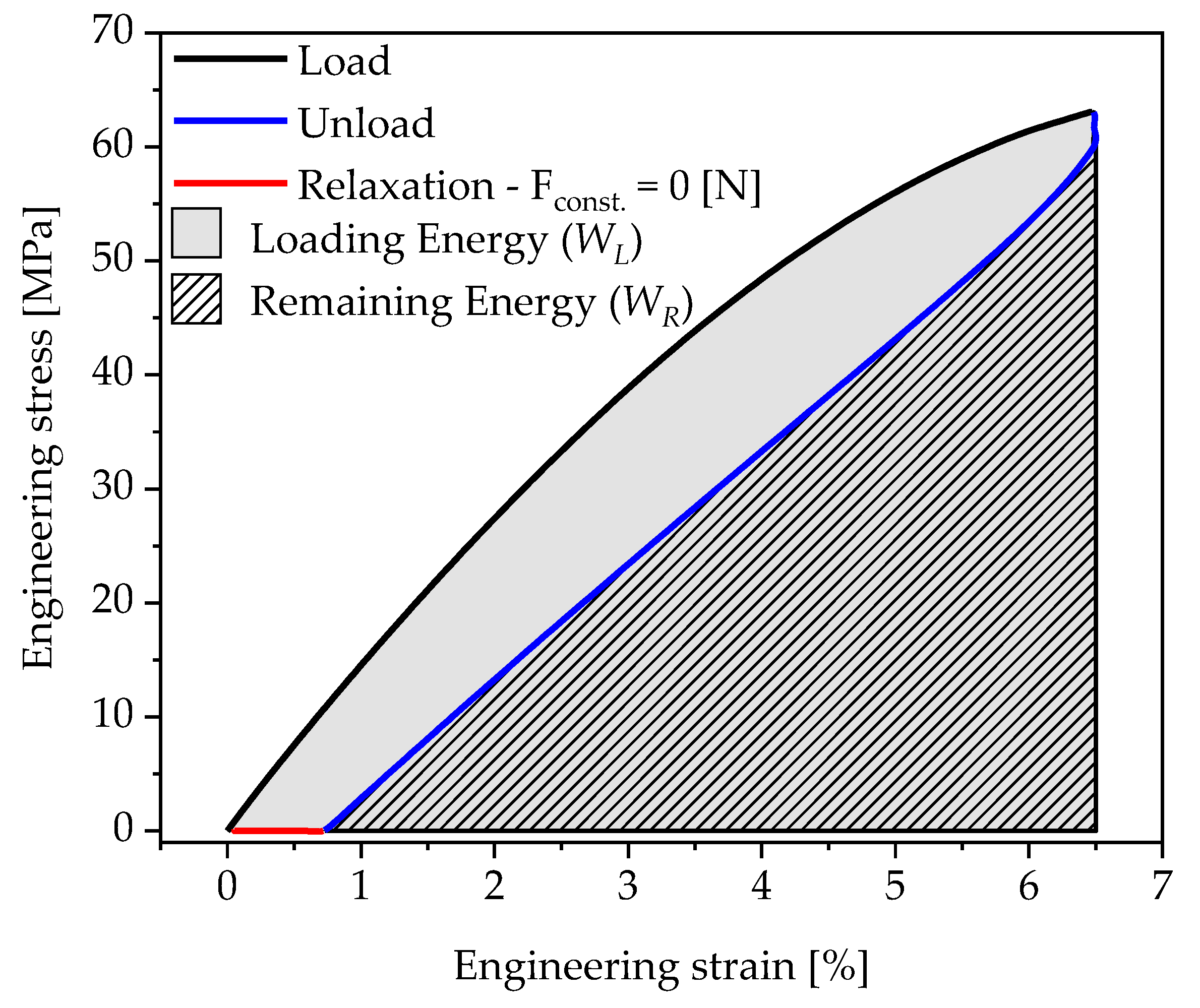

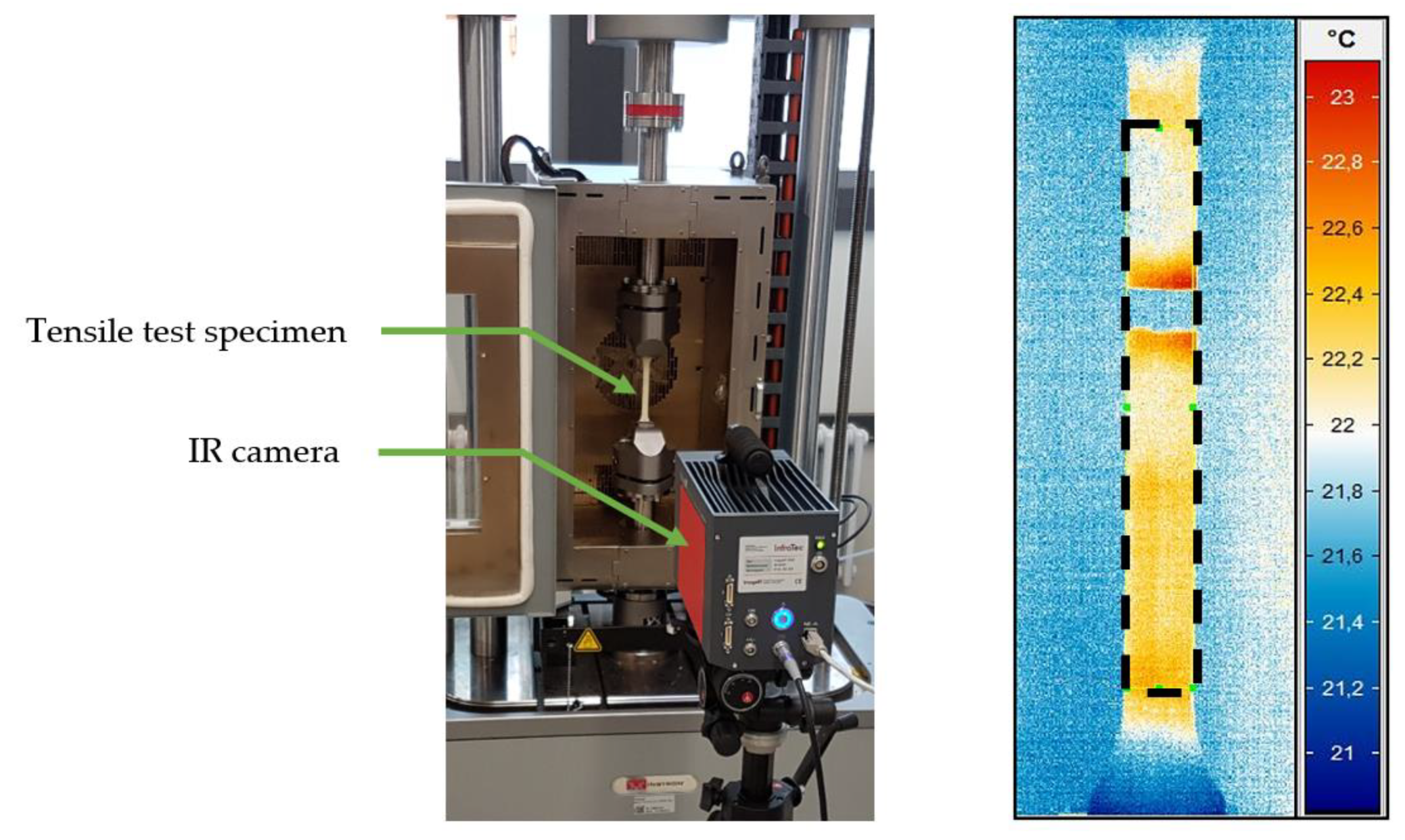

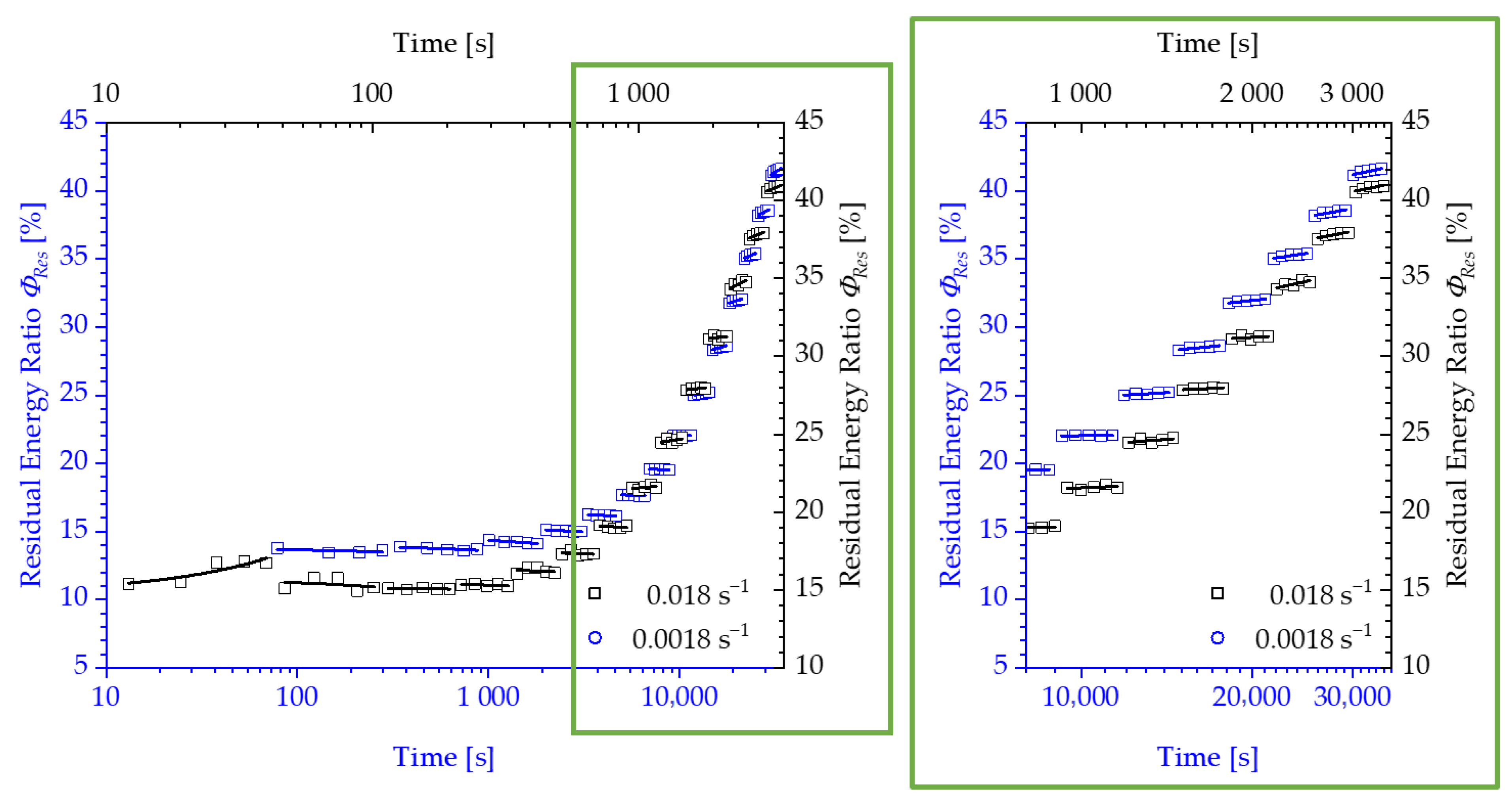

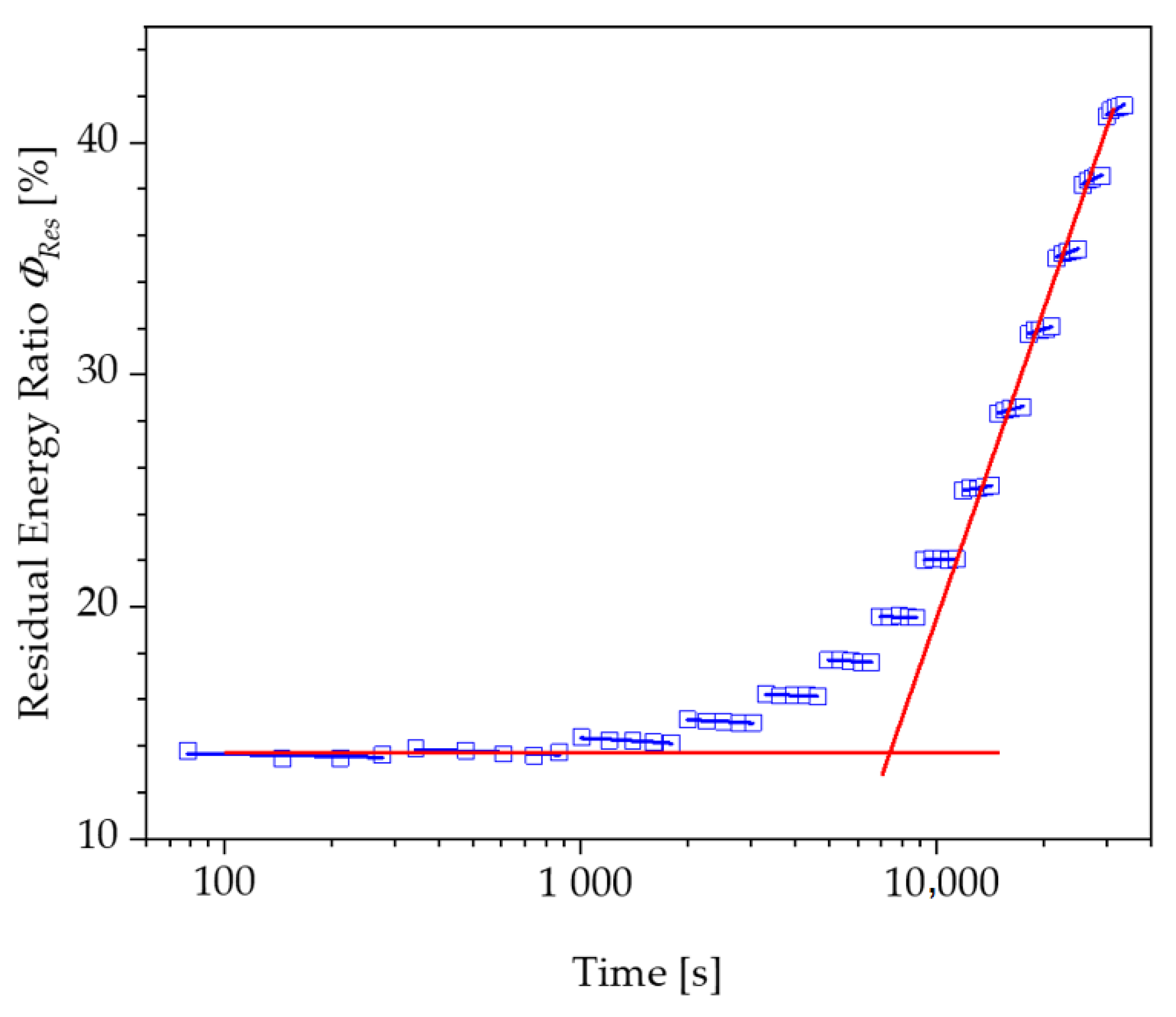
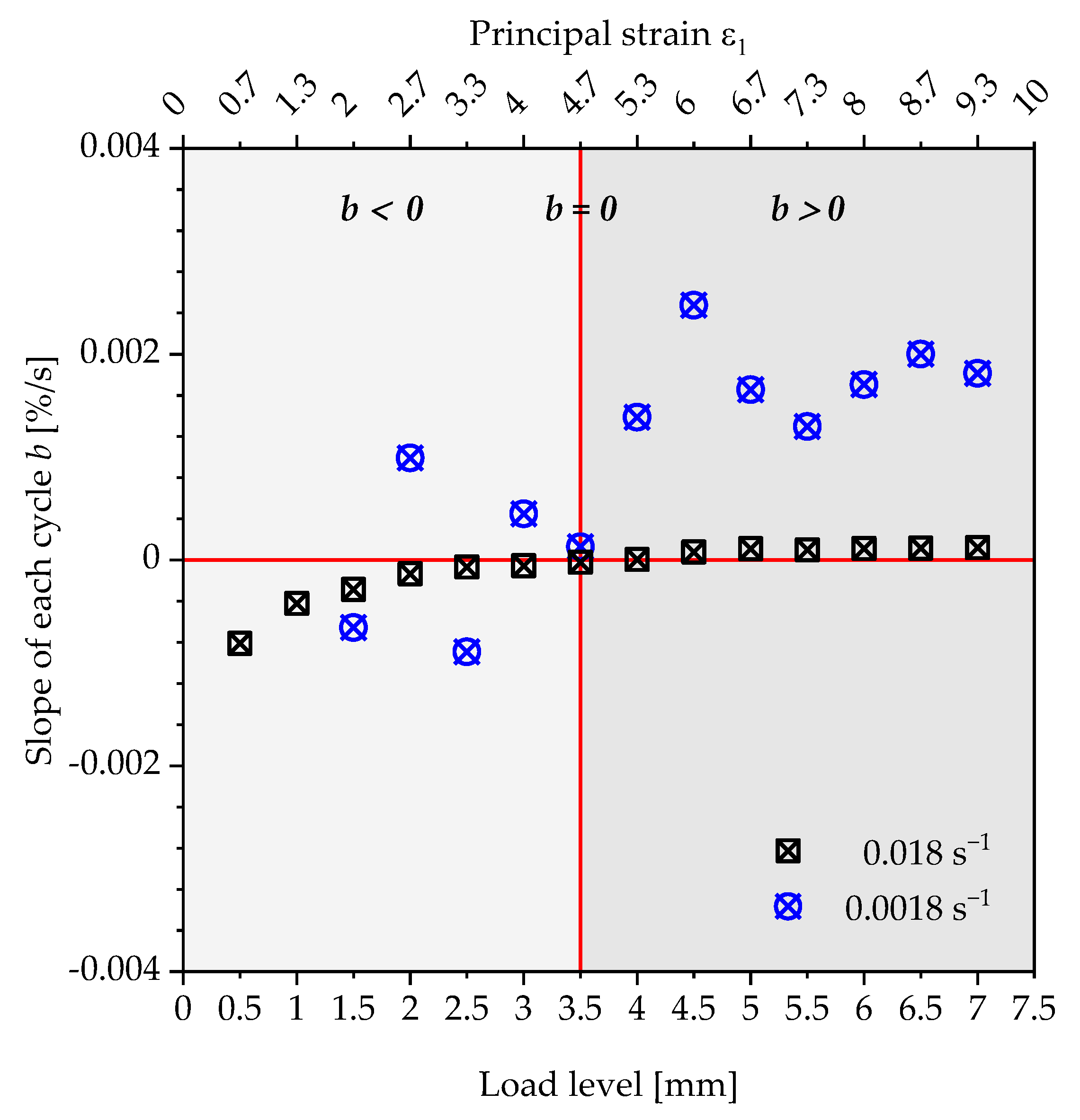
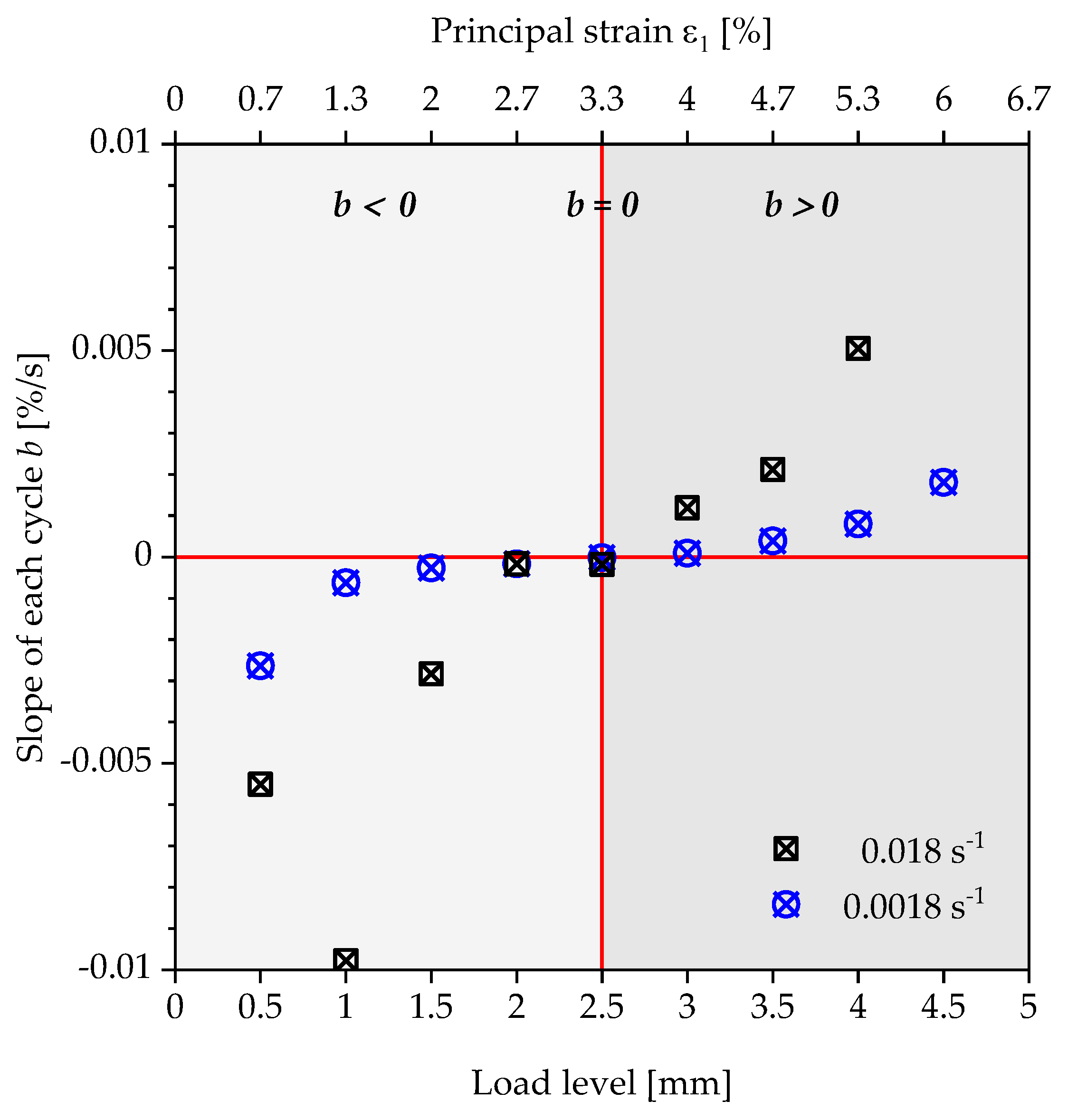
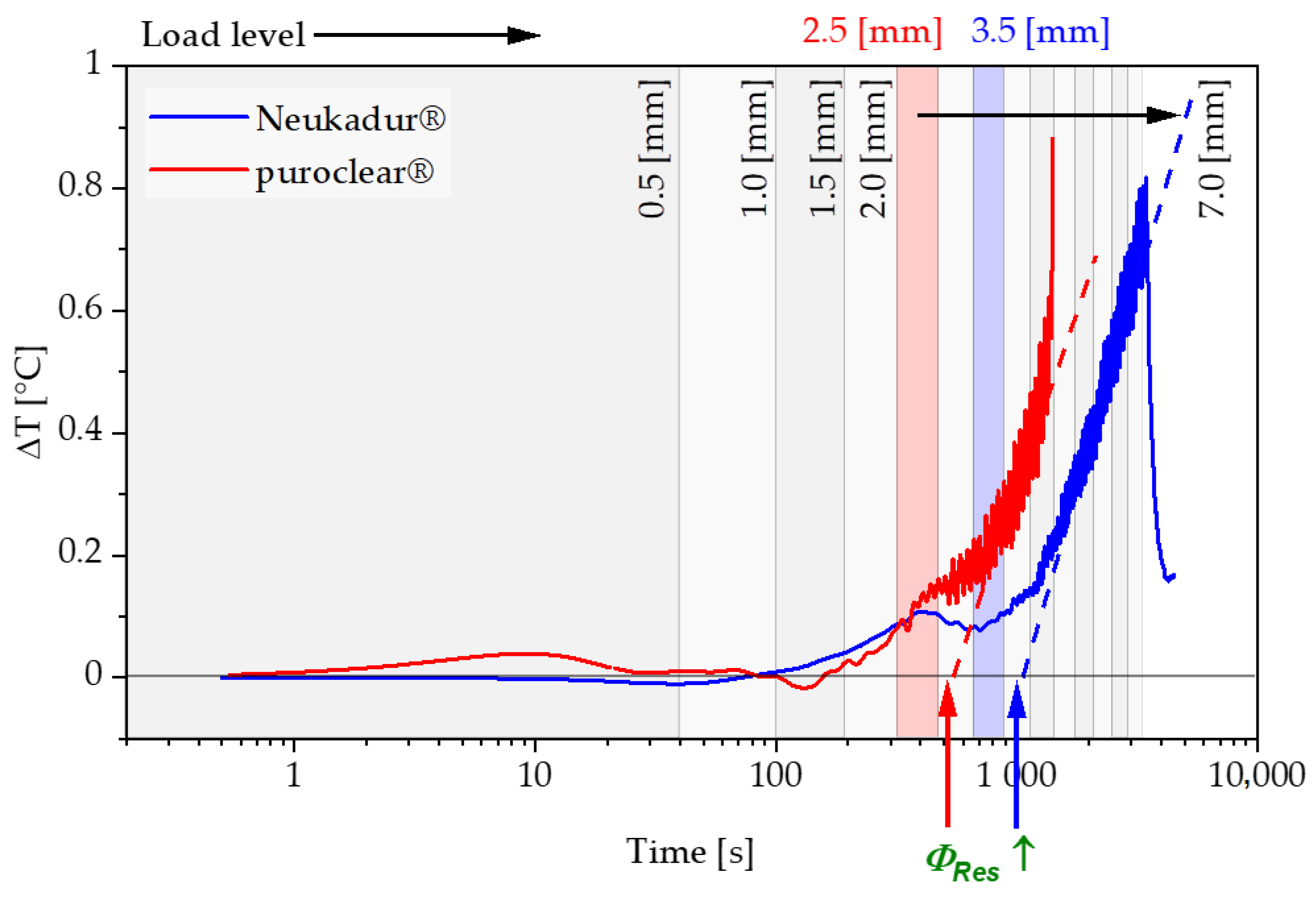

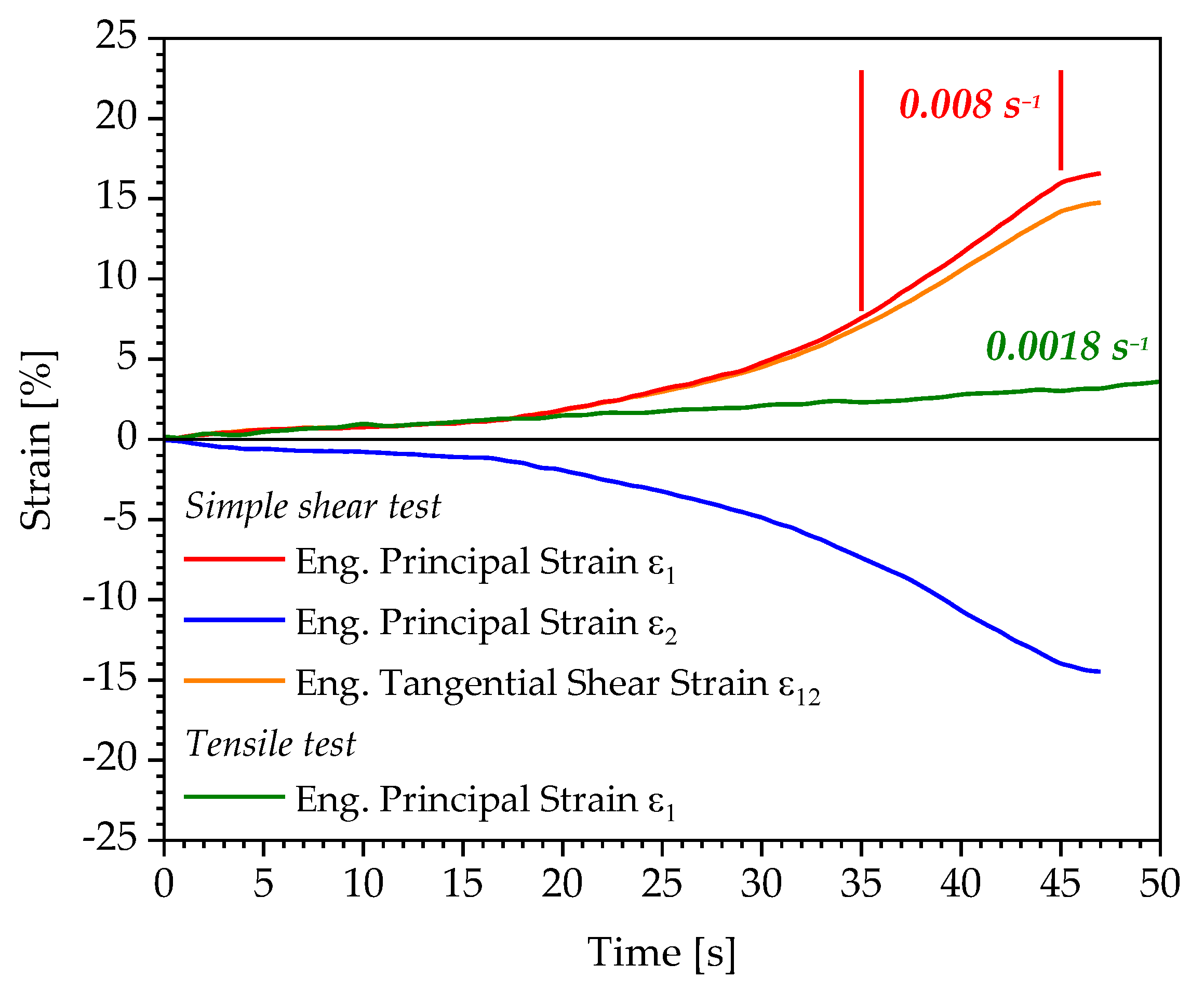
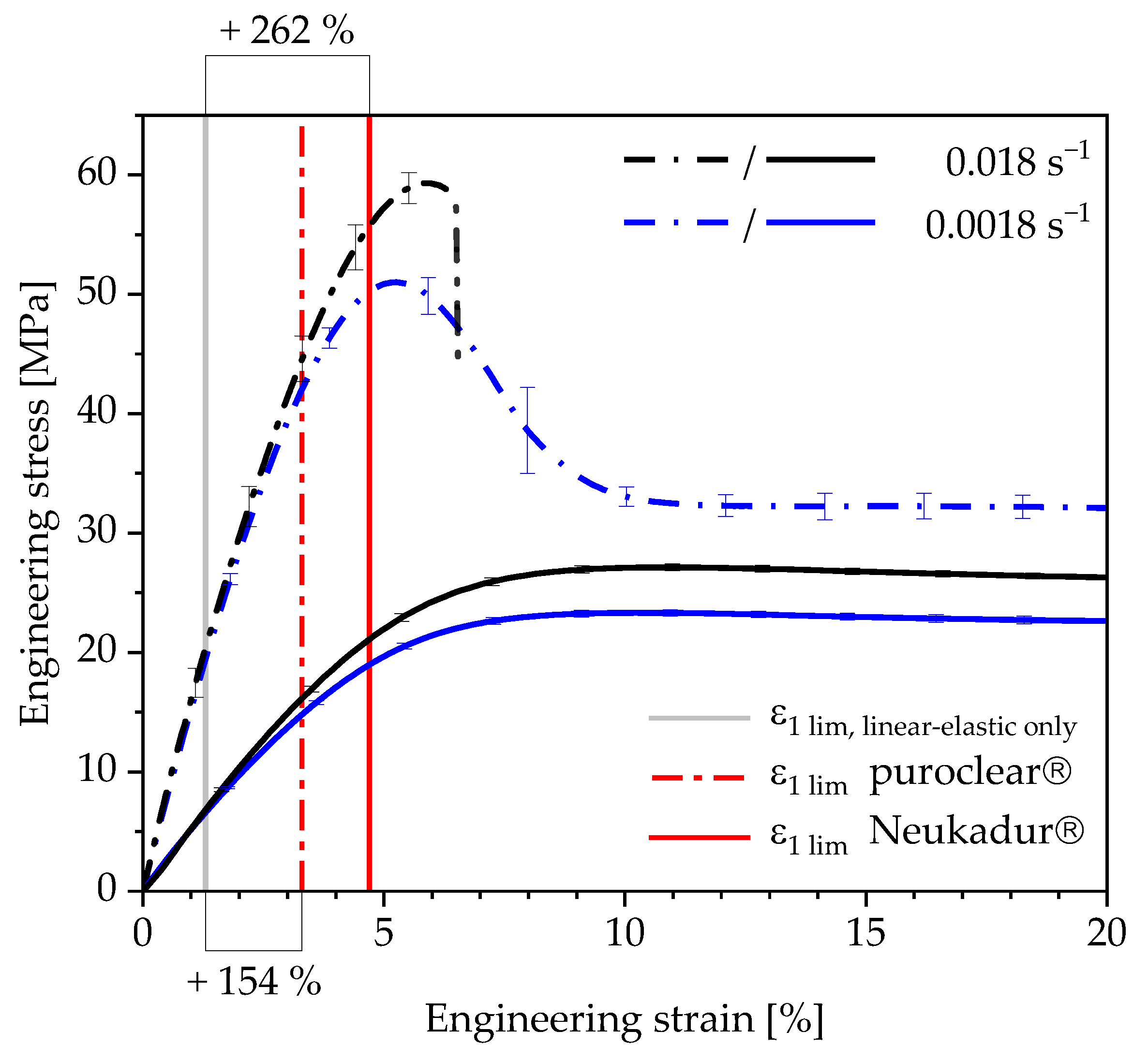
| Slope b | Residual Energy Ratio | Deformation Mechanism |
|---|---|---|
| b < 0 | cyclic stress relaxation | |
| b = 0 | change of dominating mechanism | |
| b > 0 | increasing energy dissipation |
| PUR | Strain Rate (s−1) | Load Level (mm) | Tensile Strain Limit (%) |
|---|---|---|---|
| Neukadur® | 0.018 | 3.5 | 4.7 |
| 0.0018 | 3.5 | 4.7 | |
| puroclear® | 0.018 | 2.5 | 3.3 |
| 0.0018 | 2.5 | 3.3 |
| PUR | Strain Rate (s−1) | Time load level (s) | Load Level (mm) | Tensile Strain Limit (%) |
|---|---|---|---|---|
| Neukadur® | 0.018 | 993 | 3.5 | 4.7 |
| 0.0018 | 7979 | 3.5 | 4.7 | |
| puroclear® | 0.018 | 510 | 2.5 | 3.3 |
| 0.0018 | 5105 | 2.5 | 3.3 |
| PUR | Load Level (mm) | Strain Limit (%) | ||
|---|---|---|---|---|
| Tensile Load | Shear Load | Tensile Load | Shear Load | |
| Neukadur® | 3.5 | 3.85 | 4.7 | 12.1 |
| puroclear® | 2.5 | 2.45 | 3.3 | 4.1 |
Publisher’s Note: MDPI stays neutral with regard to jurisdictional claims in published maps and institutional affiliations. |
© 2021 by the authors. Licensee MDPI, Basel, Switzerland. This article is an open access article distributed under the terms and conditions of the Creative Commons Attribution (CC BY) license (https://creativecommons.org/licenses/by/4.0/).
Share and Cite
Stanko, M.; Lehmenkühler, P.; Stommel, M. Determination of Strain Limits for Dimensioning Polyurethane Components. Polymers 2021, 13, 3198. https://doi.org/10.3390/polym13183198
Stanko M, Lehmenkühler P, Stommel M. Determination of Strain Limits for Dimensioning Polyurethane Components. Polymers. 2021; 13(18):3198. https://doi.org/10.3390/polym13183198
Chicago/Turabian StyleStanko, Michael, Peter Lehmenkühler, and Markus Stommel. 2021. "Determination of Strain Limits for Dimensioning Polyurethane Components" Polymers 13, no. 18: 3198. https://doi.org/10.3390/polym13183198
APA StyleStanko, M., Lehmenkühler, P., & Stommel, M. (2021). Determination of Strain Limits for Dimensioning Polyurethane Components. Polymers, 13(18), 3198. https://doi.org/10.3390/polym13183198








